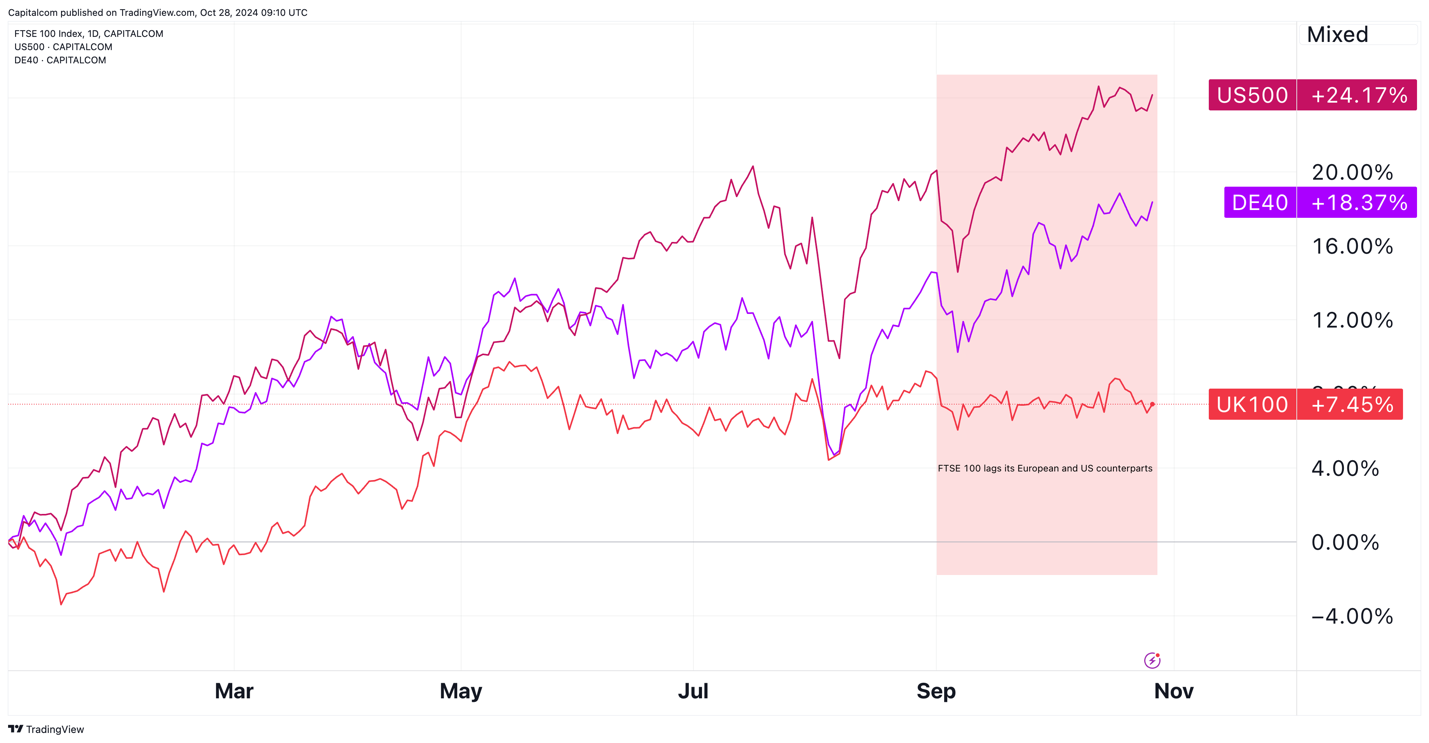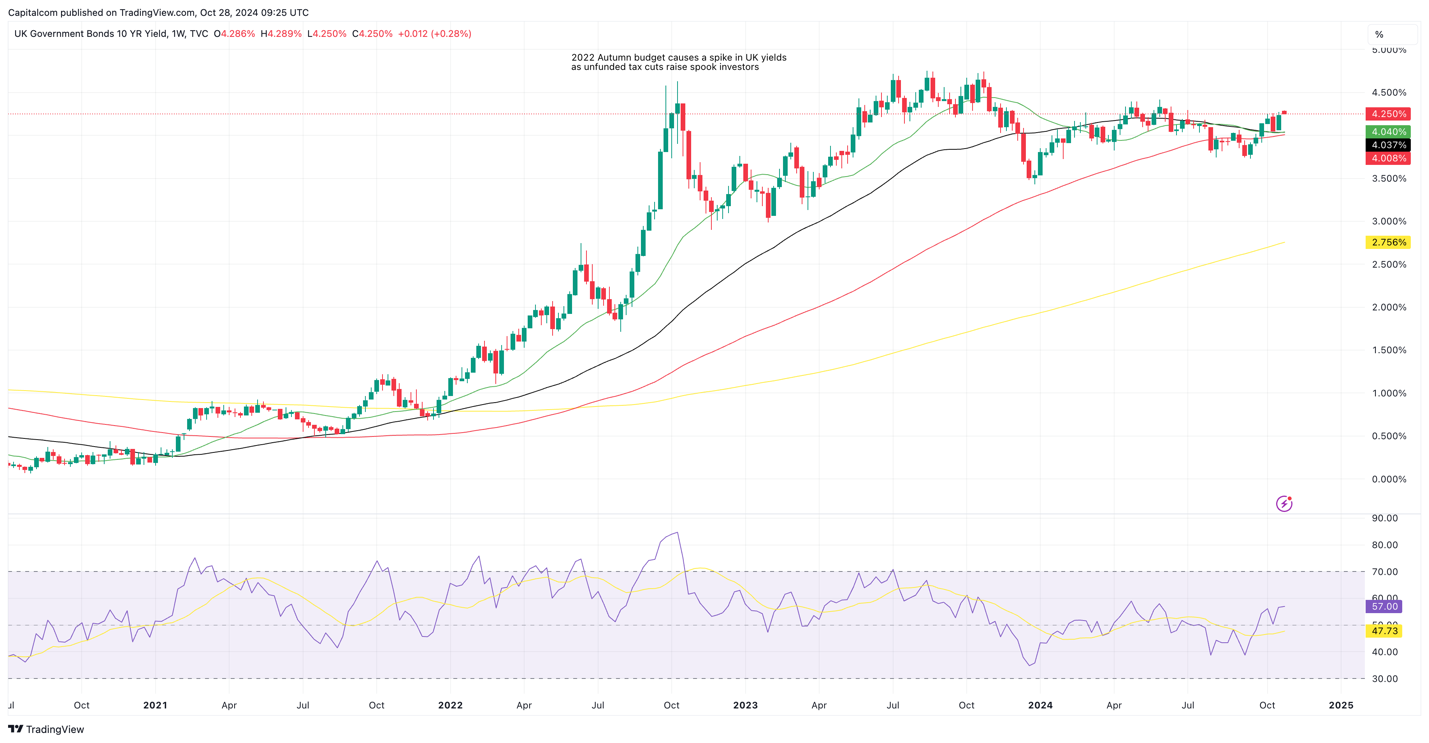UK Budget preview: how could markets react?
UK assets trade with caution ahead of the UK Autumn Budget unveiled on October 30.
UK finance minister Rachel Reeves is set to deliver her first annual budget on Wednesday. Investors will be closely watching how the Chancellor plans to balance fiscal responsibility with tax reform, supporting business, and maintaining public services. She has already hinted that a large fiscal “black hole” needs to be filled, making difficult decisions necessary.
A key concern for investors is a repeat of the 2022 crisis that saw the pound hit a 37-year low against the dollar and sent borrowing costs soaring following the announcement of a series of unfunded tax cuts. A repeat is unlikely, as politicians often learn from their mistakes – or those of their opponents – but Chancellor Reeves will need to be especially cautious with her messaging, clearly outlining any anticipated costs of proposed changes.
FTSE 100, DAX 40, S&P 500 daily chart

Past performance is not a reliable indicator of future results.
The mood in UK assets heading into the budget has been pretty bleak, especially in the stock market. Both the FTSE 100 and FTSE 250 have been trading sideways for the past few months, lagging behind their international peers. Despite expectations of a wide array of tax increases including potential hikes in National Insurance on pension contributions from employers, as well as capital gains and inheritance tax, Labour ruled out income tax increases in its manifesto. This means employees won’t face direct tax increases which could benefit consumer discretionary stocks, especially in light of lower inflation and expected further rate cuts from the BoE. Given the FTSE 250 is more geared towards domestic stocks, we could see a greater impact than in the FTSE 100.
Investor concerns grew last week as figures showed that UK borrowing for September hit £16.6bn, a £2.1bn increase from the same month in 2023, pushing public sector net debt to 98.5% of GDP. As a result, borrowing costs have risen, with the 10-year gilt now yielding 4.25%, the highest in four months. Yields had been declining steadily as inflation eased, dropping below the BoE’s 2% target in September for the first time in over three years. However, concerns about wage growth pressures remain, limiting the downside in UK yields. While further rate cuts from the BoE are expected to lower borrowing costs in the coming months, investors may be reluctant to part with higher yields until there’s confidence that the UK Autumn budget won’t negatively impact the economy.
UK 10-year yield weekly chart

Past performance is not a reliable indicator of future results.
Despite the anticipation around the budget, we may see a similar scenario to the one following the Spring budget delivered by then-Chancellor Jeremy Hunt. By sticking to what he could realistically promise, Hunt kept volatility to a minimum, and investors were grateful for that. In the absence of any far-fetched and unexpected measures, we could see the FTSE 100 gain a bit of traction as uncertainty about the budget lifts, reducing risk. The pound, however, may ignore it altogether if nothing material happens, as the FX market remains more focused on rate differentials.
GBP/USD has been left grappling for support as the US dollar surged over 4% in October, driven by improving US economic data, diminished rate cut expectations from the Federal Reserve, and the resurgence of the Trump trade ahead of the US elections. The pair has struggled to keep sellers at bay having dropped back below 1.30 over the past week. There appears to be support around 1.29 at the 78.6% Fibonacci level, but the daily chart shows weak buyer engagement, suggesting any bullish reversal could be short-lived. A break below 1.29 could open the door for further downside toward 1.2855. Any surprises from Chancellor Reeves that raise concerns about the UK economy could be a catalyst for further downside in the pair this week.
GBP/USD daily chart

Past performance is not a reliable indicator of future results.